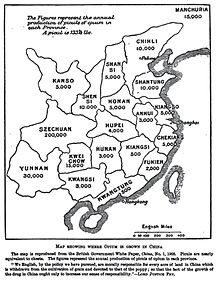Picul
| Picul | ||
|---|---|---|
Hanyu Pinyin dàn | | |
| Wade–Giles | tan | |
| Hakka | ||
| Romanization | tâm | |
| Yue: Cantonese | ||
| Yale Romanization | daam | |
| Jyutping | daam1 | |
| Southern Min | ||
| Hokkien POJ | tàⁿ | |
| Transcriptions | |
|---|---|
| Revised Romanization | dam |
| Transcriptions | |
|---|---|
| Romanization | tan |
A picul /ˈpɪkəl/[1]
or tam
History
The word picul appeared as early as the mid 9th century in Javanese. In modern Malay, 'pikul' is also a verb meaning 'to carry on the shoulder'.
Following
Definitions

As for any traditional measurement unit, the exact definition of the picul varied historically and regionally. In imperial China and later, the unit was used for a measure equivalent to 100 catties.[4]
In 1831, the Dutch East Indies authorities acknowledged local variances in the definition of the pikul.[5] In
The measure was and remains used on occasion in Taiwan where it is defined as 60 kg.[7] The last, a measure of rice, was 20 picul, or 1,200 kg.[8]The stone
While the character "石" ("stone") is normally pronounced shí (
Historically, during the
In the early days of Hong Kong as a British colony, the stone (石, with a Cantonese pronunciation given as shik) was used as a measurement of weight equal to 120 catties or 160 pounds (72.6 kg), alongside the picul of 100 catties.[6] It was made obsolete by subsequent overriding legislation in 1885, which included the picul but not the stone, to avoid confusion with European-origin measures that are similarly called stone.[10]
References
- ^ a b "picul". Oxford English Dictionary (Online ed.). Oxford University Press. (Subscription or participating institution membership required.)
- ^ a b "Weights and Measures Ordinance". The Law of Hong Kong.
- ^ Freeman Hunt, Thomas Prentice Kettell, William Buck Dana. Hunt's merchants' magazine and commercial review, Volume 41.Freeman Hunt, 1859 Google PDF download: [1]
- ^ Xīnhuá Zìdiǎn), Peking, 1984.
- ISBN 978-979-461-634-5. 318 pages quoting Algemen Verslag Resdientie Banoemas 1831: ANRIJ and ANRIJ Makassar 291/18: Chinne Verslag van de Havenmeester
- ^ a b Weights and Measures – Ordinance No. 22 of 1844, Historical Laws of Hong Kong Online.
- ^ Weights and Measures in Use in Taiwan Archived 2010-12-29 at the Wayback Machine from the Republic of China Yearbook--Taiwan 2001.
- ^ Andrade, Tonio (2005). "Appendix A: Weights, Measures, and Exchange Rates". How Taiwan Became Chinese: Dutch, Spanish, and Han Colonization in the Seventeenth Century. Columbia University Press.
- ^ 《漢書》 百官公卿表
- ^ Weights and Measures Ordinance, 1885, Historical Laws of Hong Kong Online.
